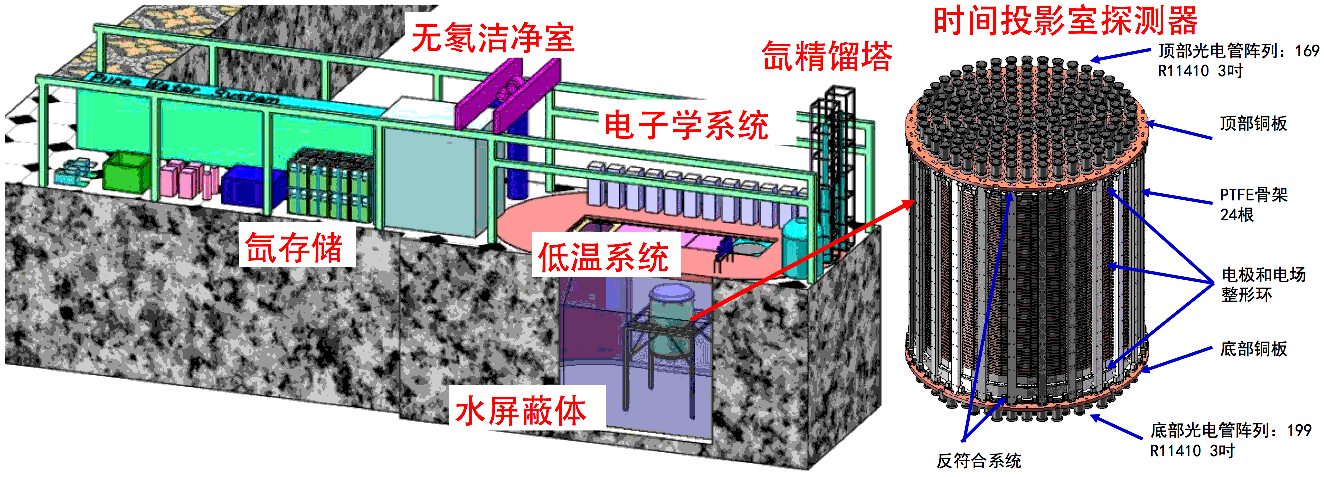
2016年PandaX二期实验(500公斤级液氙)取得了世界领先的暗物质探测灵敏度。在这个基础上,我们进行下一代四吨级液氙探测实验的研发,将暗物质探测灵敏度继续向前推进1-2个数量级。除了暗物质,四吨级液氙实验将能够测量到低能量太阳中微子信号并研究其磁矩等性质。另外,四吨液氙中含有的放射性同位素氙136有可能进行一种新型的贝塔衰变-无中微子双贝塔衰变模型。该衰变模式的探测将能确定中微子是否为马约拉纳中微子等基本物理问题。
After reaching the world-leading dark matter detection sensitivity with PandaX-II (500 kg Xenon) experiment in 2016, we are developing the next generation dark matter experiment with 4-ton liquid xenon in the detector sensitive volume. The goal is to push the dark matter sensitivity down to $6\times10^{−48} cm^{2}$ (spin-independent dark matter-nucleon scattering cross section), which is a 1-2 magnitude improvement to current value. Besides the dark matter, PandaX-4ton also has a good sensitivity to low energy solar neutrino detection and neutrino magnetic momentum. $^{136}Xe$ (natural abundance 8.9%) in the 4-ton detector may have neutrinoless double-beta decay signal, detection of such a mode will answer some fundamental questions of neutrinos.

本项仪器提出以下技术性能和指标:
- 液氙靶物质灵敏区域的体量达到4吨,这比PandaX-II的探测仪大了约10倍。为了达到这个要求,总的氙气需求约5.5吨以上。
- 放射性本底水平:在暗物质信号范围内(10keVee以下)达到0.05mDRU ( DRU=1事例/天/公斤靶物质/keV能量)。
- 探测仪性能:探测仪的光产额可以达到5光电子/keV反冲能,最低可以探测到5keV的核反冲能量,位置分辨率能够达到5-10毫米,暗物质探测区域能量分辨率达到3%。这个要求在探测仪做大的同时,保持低能探测灵敏度。
- 稀有物理探测灵敏度:对50 GeV/c2暗物质粒子与核子自旋无关的散射截面灵敏度达到$6\times10^{−48} cm^{2}$;能够测量到低能太阳pp中微子通量,精度达到20%;能对无中微子双贝塔衰变进行测量。
The 4-ton experiment will adopt the two-phase (liquid xenon and gas xenon) design of Time Projection Chamber which has a cylinder shape with a height of 1.2m and a diameter of 1.2m. The design goal is to have:
- 4-ton xenon in sensitive volume
- Radioactive background level below 0.05 mDRU ( 1DRU= 1 event /day/kg/keV )
- Light yield in detector at 5 PE/keV, energy detection threshold at 5keV, position resolution at 5-10 mm, energy resolution at 3%
- Spin-independent scattering cross section sensitivity at $6\times10^{−48} cm^{2}$, being able to detect low energy solar neutrino with precision of 20%, having ability to detect $^{136}Xe$ neutrino-less double beta decay
为了达到该物理目标,整体实验设计上产生很多新的挑战并需要各种性能优化。为此, 我们组成七个子系统来分别进行研发:时间投影室探测系统、光电探测系统、前端电子学系统、触发和数据获取系统、气体存储和处理系统、低温系统、低本底控制系统等。
In order to reach the physics goal, new challenges arise and several optimizations are required in the experiment design. Several sub-systems are formed to address these issues: TPC detector, PMT light detection system, Front-end electronics, Trigger and DAQ, Cryogenics system, Xenon purification and storage and Low-radioactivity control system.

本项目组依托于上海交通大学粒子与核物理研究所和李政道研究所,并与中国科学技术大学,北京大学,山东大学和南开大学等相关实验室直接合作。该项目计划在2020年全面取数至2022年积累5至6吨年的有效曝光量,发表全部数据分析结果,预期获得世界最为灵敏的暗物质探测水平。之后我们计划进行30吨级终极暗物质探测实验,全面覆盖暗物质的参数空间。
PandaX-4ton experiment is supported by Institute of Nuclear and Particle Physics (INPAC) and T.D. Lee Institute, with collaborations from University of Science and Technology of China, Peking University, Shandong University and Nankai University. This project is scheduled to complete construction and take data in 2020. With 2-year exposure, it is supposed to give the highest dark matter detection sensitivity in the world. After that, a 30-ton ultimate dark matter detector would be the next step.
